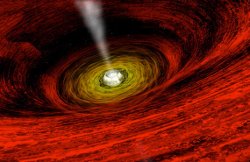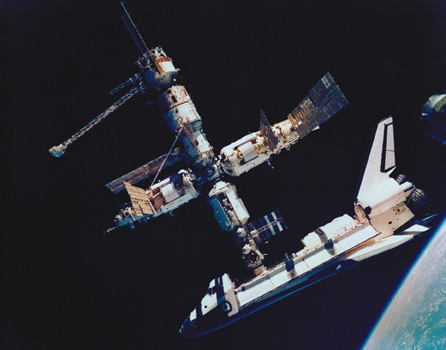|

|
Prelude
to Armageddon
(Teacher Page)
|

|
A
WebQuest for
9th
Grade Earth Science
Designed
by:
Anthony
Greer
and Richard
Catalano

Introduction
|
Learners
|
Standards
|
Process |
Resources
|
Evaluation
|
Conclusion
|
Credits |
Student Page
Introduction
This
lesson was designed for a project in EDUC 410 at the State University
of New York @ Potsdam. EDUC 410 or Media and Technology is a
cognate requirement for those seeking a degree in
Education.
This
lesson will teach the students about the planets in our solar
system. It will peak their interest into something different
that they hopefully have not yet explored. The groups of
students (Team Genesis) will research facts about each of the planets
of our solar system and determine if there is a way that one or all
of the planets could be inhabited. Then the students will build
a 3-dimensional model of what one of these structures would look
like.
Go
to top of page
Learners
This
lesson is geared for 9th grade Earth Science students.
This WebQuest can be interwoven with Language Arts, where the
students could have their papers proof-read and submitted for a
grade. This could also be put into the Art program with their ShoeBox
Model of a living environment. The students should have a
knowledge
of
how to use the internet, and how to pick out pertinent
data.
Go
to top of page
Curriculum
Standards
The
students will learn how to use the library and internet from doing
their research for the project. All standards used will be
based on the New
York State Department of Education
Physical
Setting/Earth Science Core
Curriculum.

- Standard
# 2: Information Systems
-
Students will access, generate, process, and transfer information,
using appropriate technologies.
Key Idea # 1 -
Information technology is used to retrieve, process, and
communicate information as a tool to enhance
learning.
Performance
Indicator # 1.1 - Use
a range of equipment and software to integrate several forms of
information in order to create good-quality audio, video, graphic,
and text-based presentations.
Performance
Indicator # 1.2 -
Use
spreadsheets and database software to collect, process, display,
and analyze information. Students access needed information from
electronic databases and on-line telecommunication
services.
Performance
Indicator # 1.3 - Systematically
obtain accurate and relevant information pertaining to a
particular topic from a range of sources, including local and
national media, libraries, museums, governmental agencies,
industries, and individuals.
Key Idea # 2 -
Knowledge
of the impacts and limitations of information systems is essential
to its effectiveness and ethical use.
Performance
Indicator # 2.1 -
Understand
the need to question the accuracy of information displayed on a
computer because the results produced by a computer may be
affected by incorrect data entry.
- Standard
# 6: Interconnectedness: Common Themes
-
Students
will understand the relationships and common themes that connect
mathematics, science, and technology and apply the themes to these
and other areas of learning.
Key Idea # 6: Optimization - In
order to arrive at the best solution that meets criteria within
constraints, it is often necessary to make
trade-offs.
Performance
Indicator # 6.1 - Determine
the criteria and constraints and make trade-offs to determine the
best decision.
- Standard #
7:
Interdisciplinary Problem Solving -
Students
will apply the knowledge and thinking skills of mathematics,
science, and technology to address real-life problems and make
informed decisions.
Key Idea # 2 -
Solving
interdisciplinary problems involves a variety of skills and
strategies, including effective work habits; gathering and
processing information; generating and analyzing ideas; realizing
ideas; making connections among the common themes of mathematics,
science, and technology; and presenting results.
Performance
Indicator # 2.1 -
Students
participate in an extended, culminating mathematics, science, and
technology project. The project would require students to:
• Working Effectively: Contributing to the work of a
brainstorming group, laboratory partnership, cooperative learning
group, or project team; planning procedures; identify and managing
responsibilities of team members; and staying on task, whether
working alone or as part of a group.
• Gathering and Processing Information: Accessing
information from printed media, electronic data bases, and
community resources and using the information to develop a
definition of the problem and to research possible solutions.
• Generating and Analyzing Ideas: Developing ideas
for proposed solutions, investigating ideas, collecting data, and
showing relationships and patterns in the data.
• Common Themes: Observing examples of common unifying
themes, applying them to the problem, and using them to better
understand the dimensions of the problem.
• Realizing Ideas: Constructing components or models,
arriving at a solution, and evaluating the result.
• Presenting Results: Using a variety of media to
present the solution and to communicate the results.
- Standard #
4: Physical Setting -
Students
will understand and apply scientific concepts, principles, and
theories pertaining to the physical setting and living environment
and recognize the historical development of ideas in
science.
Key
Idea # 1 - The
Earth and celestial phenomena can be described by principles of
relative motion and perspective.
Performance
Indicator # 1.1 -
Explain
complex phenomena, such as tides, variations in day length, solar
insulation, apparent motion of the planets, and annual traverse of
the constellations.
Major
Understanding # 1.1a -
Most objects
in the solar system are in regular and predictable
motion.
Major
Understanding # 1.1b -
Nine planets move around the Sun in nearly circular orbits.
• The orbit of each planet is an ellipse with the Sun located
at one of the foci.
This lesson
will also teach your students how to work in groups. They will
learn how to do research in both the library through books but also
on the Internet. Your students will have to learn to
communicate their ideas with their teammates and also with you in the
form of a summative essay. The students must be creative in how
they design the ShoeBox model, while paying attention to detail
and explaining whey they did what they did.
This lesson is
designed for students to productively work within groups and at the
same time work along side the teacher. Questions will be encouraged
by the teacher at any point throughout this project. This lesson
should encourage creative production within the group as well as
ample amounts of teamwork and compromise in order to submit a
finalized result.
Go
to top of page
Process
In order to
complete this assignment you must follow these
guidelines:
- You will be assigned to groups
of 3-4 students.
- Since the planet Earth can not
sustain life in the future, there is no need to research this
planet. Each group member will research 1-3 planets and report
their findings to the entire group.
- Use given resources, texts,
encyclopedias and the library to research and complete the first 6
steps of the task listed above.
- Be sure to submit your one
page progress report to the Director of NASA (your teacher) at the
end of your first week.
- Also, the end of your first
week will be the time to ask any questions to your teacher you
have to date regarding your findings.
- During your final week of
preparation, collaborate with all members of Team Genesis in order
to layout your research so that it will be presentable to your
colleagues (your classmates). Also, create a work cited page to
let the Director of NASA (your teacher) know where you got your
information.
- After the two weeks are up,
you and your team will present your findings along with your
shoebox model to your colleagues (classmates) as well as the
Director of NASA (your teacher).
|
Remember
the groups should be assigned and not picked by the
students, this way you will be less likely to get groups
that will be all talk and no work. One procedure I
found to be useful, is arrange all your students on a
datasheet in order from highest grade to lowest. Then
count down the list up to the number of groups you have and
repeat all the way down. This will allow you to mix up
the abilities of every group.
This
project will take two weeks in two complete. Some time
should be spent in class before it starts giving the
students some background information on the Solar
System. If feasible, a trip to a planetarium to show
the students some constellations or planets would be useful
to peak the students interest in the subject. The
first half of the first class period spent on the project
should be a trip to your school library, so that the
librarian can show the students how to use the library
resources. The second half should be spent in a
computer lab where there is enough computers for each
student in your class, so that they can commence their
research.
|

|
The major areas where
students may encounter problems is in the researching of facts. This
is why it is imperative for the teacher to spend just a couple of
minutes each day with each group to make sure they are on the right
track as well as to answer any questions that the group may have.
Variations
If you want
to vary this lesson you can have your groups be teams for each planet
that is to be researched. You would have to add some more
guidelines to the process on what they would be researching
though.
Go
to top of page
Resources
Needed
To
implement this lesson, your class will need access to a computer lab,
in which each group will be able to be use a computer at the same
time.
All
the websites used in this WebQuest can be found in
the
Credits
section.

Besides
spending the first half of class on the first day in the library
allowing students to learn properely how to navigate through
resources in order to obtain information, this is really all the
direction they will need. Students have already been encouraged to
use as many resources as possible. Finally, considering this project
is spread out and will take two weeks to complete, the content
teacher will be sufficient in terms of aiding this learning
process.
Go
to top of page
Evaluation
|
|
Beginning
1
|
Developing
2
|
Accomplished
3
|
Exemplary
4
|
Score
|
|
Team's
Hypothesis for Sustainable Life on Different
Planets
|
Hypothesis was not very well
planned. No facts to support argument. Length was too not
adequate.
|
Some thought was put into
the hypothesis but is still too short. Too much speculation
with little facts.
|
Hypothesis was well thought
out. Arguments were supported with some facts and some
speculation.
|
Hypothesis was well thought
out. Arguments were supported with facts, not speculation.
Defended both sides of argument. Was of adequate
length.
|
|
|
Ability
to Retrieve Facts on the Different Planets.
|
No facts, all speculation.
No proof of where information was retrieved.
|
Facts were found for some
planets.
|
Most of the information
retrieved was true, with resources cited.
|
All facts are true, with
resources cited.
|
|
|
Essay
|
Half of the required length
or shorter. Too much speculation, few facts to back up your
arguments.
|
Essay was choppy, did not
flow well. Sections were too short. Some facts, but still
too much speculation.
|
Was of required length. Flow
of essay was good. Few speculations, mostly facts. Shared
some interesting facts.
|
Paper was well thought out.
Flowed well in between planets. Sections were of assigned
length or longer. Interesting facts were presented to the
team.
|
|
|
Use
of Resources (i.e. Works Cited Page, Different Types of
Media Used)
|
Had only one source. Did not
follow citation guidelines.
|
Used two sources. Only one
kind of media. Works cited page is not adequate.
|
Used three to four sources.
Cited all sources, used different types of media.
|
Used five or more sources,
cited all sources used. Received adequate information from
each source used. Used three different types of
media.
|
|
|
Shoebox
Diagram
|
Did not present one or very
little time and effort put into it.
|
Little explanations. Not
very creative. Attention to detail was slim.
|
Well constructed, with
explanations. Good attention to detail.
|
Attention to detail was
intact. Creative, and well explained.
|
|
|
Peer
Evaluation
|
Team member did not stay on
task. Did not get their share of the work done.
|
Team member did not
contribute much. Had assignments in on a timely
manner.
|
Team member slacked at
times, but overall was a key contribution to the group.
|
Team member contributed
equally to all parts of the project. Was on task at all
times, and very well presented.
|
|
The
quality of the students' final project presented to the entire class
will be the one task that will be evaluated with the most weight.
Along with this project, the students will be tested at the end of
this unit (Solar System) during their regular class
time.
Go
to top of page
Conclusion
This
WebQuest will not only peak the students interest in our solar system
but at the same time allow students to research and find information
using an array of resources. Some of this information will be needed
in order for their projects to be completed but also, we allowed room
for students to find facts that are of particular interest that they
would like to share with the rest of the class.
This
allows for creative thinking and teamwork because each group will
want to bring some fact up in their discussion that sparks not only
the teacher's interest, but their peers' interest as well.
Finally
this WebQuest will inform students of why our planet is inhabitable
today and why other planets may or may not be. And considering that
commercial space travel and visiting other planets is inevitable,
this will allow the students (who are the generation that will
eventually partake in these futuristic events) to learn as much as
they can about this topic.
Go
to top of page
Credits

The
Nine Planets
-
This website is actually linked to Blackboard within the Academic Web
Resources page and proved to be a valuable link in order to find many
interesting facts regarding our solar system.
Google
Image Search
-
Within this site we were able to obtain mostly all the pictures and
.GIF's we used in our Webquest.
NASA
-
This website allowed us to research any prior efforts that have been
made in the past to find life on other planets. (e.g.. the Mars
landing) Also, we were able to get an idea of what space travel
entails for an astronaut.
Life
On Other Planets
-
This website allows students to see first hand what type of factors
are involved in finding life on other planets than earth. It
discusses each planets environmental factors, which would cause
problems for human existence.
Hubble
Telescope
-
This website gives a good insight on how the universe is looked at
today.
New
York State Department of
Education
-
This website is where are the standards for this project were
found.
Go
to top of page
Last
updated on
October
31, 2002
.
Based
on a template from
The
WebQuest Page.



